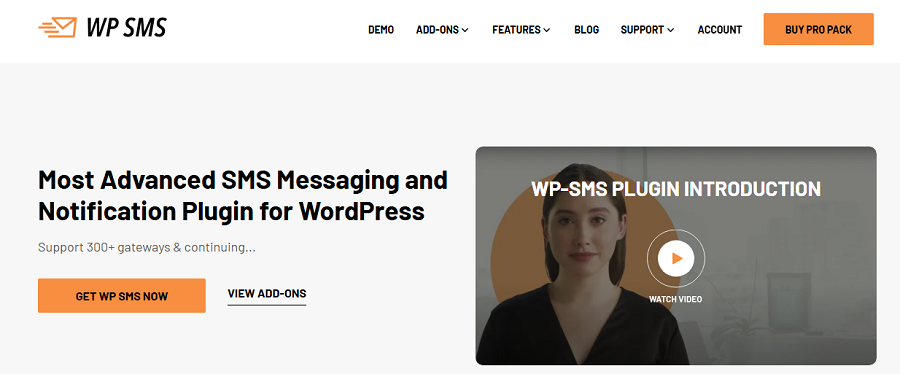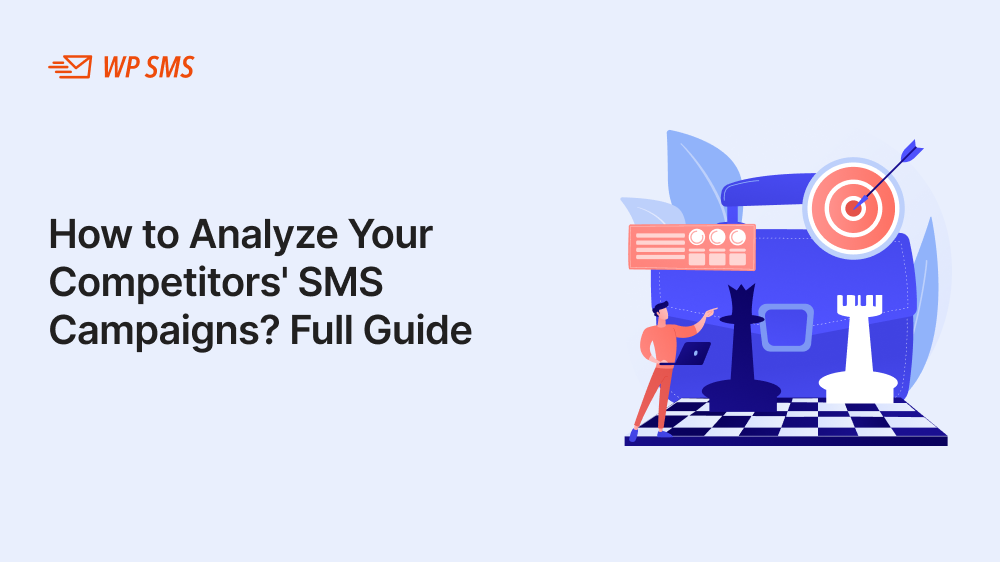Competitor analysis is essential to every marketing strategy, and SMS marketing is no exception. SMS competitor analysis helps you learn SMS marketing best practices and avoid trial and error in many tasks.
If you know what your competitors do to reach success, you can reduce your mistakes and improve your marketing efficiency.
In this blog post, we’ve gathered the best practices for analyzing your competitors’ SMS campaigns and optimizing your strategies.
Also, we’ll explain how you can use WP SMS to implement what you’ve learned from your competitors.
The Importance of SMS Competitor Analysis
SMS competitor analysis has several benefits, such as:
- Benchmarking Performance: Analyzing your competitors’ performance gives you a baseline to measure the success of your own SMS marketing strategies.
- Learning Best Practices: If you’re a beginner and don’t have any idea about successful strategies, you can get ideas from your competitors.
- Spotting Gaps in the Market: By analyzing competitors’ messaging, offers, and frequency, you can discover the customer needs that your competitors have not met.
- Enhancing Engagement: You can start your campaigns with previous successful strategies and get higher engagement rates.
- Avoiding Mistakes: Learning from competitors’ mistakes helps prevent potential pitfalls in your own SMS campaigns.
So, don’t start your SMS marketing campaign before analyzing your competitors’ marketing strategies.
Tips to Analyze Your Competitors’ SMS Campaigns
Now, let’s see how you can make the most out of SMS competitor analysis:
1. Subscribe to Their SMS Campaigns
First, subscribe to their SMS campaigns and review their messages as if you were a customer.
This is one of the easiest ways to monitor your competitors’ SMS strategies. You just need to sign up for their newsletters, loyalty programs, or promotional alerts and analyze the text messages they send to you.
You can also use multiple phone numbers to monitor variations in messaging. Also, try to track different brands within your industry and monitor overall trends.
This way, you can obtain first-hand insights into how your competitors communicate with their audience.
2. Analyze their SMS Content
You have to analyze the content of each text message in detail. Try to consider everything, including:
- Tone and Language: Look at the messages to see how your competitor talks to their audience. Is the messaging language formal, friendly, or playful?
- Call-to-Action (CTA): List their CTAs to see what they ask their audience to do. Are they encouraging users to click a link, visit a store, or reply with a keyword?
- Urgency and Exclusivity: See how they make their audience take immediate action. Look for phrases like “limited-time offer” or “exclusive deal for you.”
- Use of Emojis and Visual Elements: Are they incorporating symbols or formatting to make messages stand out?
Try to come up with new ideas for yourself and combine them with what your competitors use to create an optimized SMS strategy.
3. Evaluate Their Messaging Frequency
Another important factor you need to track in your competitors’ campaigns is the frequency of their messages.
You can’t send too many text messages to your audience and expect high engagement. This might annoy recipients and make them block your number. So you have to monitor the number of SMS ads in your competitors’ marketing campaigns to find the optimal frequency.
Try to figure out:
- How often do they engage their audience?
- If they have a pattern (e.g., daily, weekly, monthly).
- How many promotional and transactional messages do they send?
- If they send ads during holidays or peak shopping seasons.
Of course, you shouldn’t just repeat what they do. However, collecting this data helps you optimize your campaigns.
4. Check Messages in Terms of Segmentation & Personalization
SMS marketing segmentation and personalization help you send targeted SMS messages and increase customer engagement.
Try to check your competitors’ SMS messages to see what type of segmentation and personalization they use. For example, if they use the recipient’s first name or last name.
Also, check if they send location-based promotions or offers based on previous behavior (e.g., abandoned cart reminders or product recommendations).
It’s also important to see whether they categorize their customers into groups like VIP members and new sign-ups.
Use the results of this competitor analysis to see what type of segmentation is better and how you can personalize your SMS campaigns.
5. Monitor Their Campaign Goals
Try to figure out the goal of each SMS marketing campaign and list the most frequent goals of your competitors.
To do this, you should check your competitors’ calls-to-action (CTAs), links, landing pages, offers, and similar elements.
When you’ve identified their main objectives, you can assess them considering your own resources and needs, then define SMART goals for your SMS campaigns.
6. Track Their Compliance with Regulations
Regulatory compliance is crucial in SMS marketing. If you don’t comply with local and international regulations, you might face legal fines.
For example, some regulations require you to get clear consent before sending promotional messages.
Competitor SMS campaign analysis is a great way to see how your competitors handle these regulations.
You can assess if competitors:
- Run opt-in campaigns
- Include opt-out options
- Comply with SMS length and timing restrictions
7. Analyze Their Landing Pages and Post-Click Experience
Many promotional and transactional messages redirect recipients to landing pages and ask them to do something.
In your competitor analysis, try to check the performance of your competitors’ landing pages and click-through rates.
It’s a good idea to analyze their page load speed and compare it with your own. Also, analyze their pages in terms of design and mobile friendliness.
The phrasing of their CTA is also important. For example, “purchase” and “sign up” are common. You can think of more creative phrases, but make sure that the CTA is clear enough.
Additionally, check if they use:
- Branded short links: Custom URLs that reinforce brand identity.
- Third-party shorteners: Generic tools like Bit.ly.
- UTM Parameters: Trackable links to analyze the performance of your campaign.
Try to use your competitors’ experience to optimize your landing pages, links, and CTAs to increase customer satisfaction and boost your sales.
8. Stay Updated on Trends
Marketing trends change rapidly, and SMS marketing is no exception. If you don’t stay updated, your engagement rate may decrease, and your customers may turn to other brands.
So try to analyze your competitors to see:
- Adoption of new technologies like AI-driven personalization and rich media messaging like RCS.
- Cross-promotion with social channels.
- Providing customer service using SMS.
Try to stay ahead of these trends and outperform your competitors in SMS marketing.
9. Track Their Sender ID and Use of Short Links
You can use various sender IDs in your SMS Campaigns. It’s good to take a look at your competitors’ SMS campaigns to see what they use.
Then try to choose between the following options:
- Short codes: Memorable and often used for mass marketing.
- Long codes: Resemble standard phone numbers and are used for two-way communication.
- Alphanumeric IDs: Brand names used for trust and recognition.
10. Monitor Their Social Media Profiles
Using a single marketing channel is not an effective approach. Social media often complements SMS marketing, so you have to think of an omnichannel strategy to increase the ROI of your campaigns.
So try to monitor your competitors’ activities in terms of:
- Posts that promote SMS sign-ups.
- Customer feedback about SMS campaigns.
- How they integrate SMS with social contests or promotions.
Leverage WP SMS to Outperform Your Competitors

Analyzing your competitors’ SMS campaigns is only the first step. Next, you have to build a strong strategy based on your competitive research and put it into action.
Of course, you need to use a versatile SMS tool to automate your campaigns and reduce the time and effort required for SMS marketing.
You need to choose a tool that integrates well with your current platforms, like websites, online shopping platforms, etc.
For instance, WP SMS is the best option for businesses that use WordPress websites and online shopping platforms like WooCommerce.
This SMS plugin provides everything you need to create, automate, and refine SMS marketing campaigns effortlessly.
With WP SMS, you can:
- Automate personalized SMS messages at scale.
- Segment your audience for targeted marketing.
- Integrate with WordPress and other platforms seamlessly.
- Ensure compliance with SMS regulations like GDPR.
So, why wait? Try the free plan of WP SMS to explore its capabilities, then choose a premium package to start your professional SMS marketing journey.
Conclusion
SMS competitor analysis is a great method for optimizing your SMS marketing strategy and minimizing mistakes. When you see what strategies have been successful for your competitors, you can repeat them or even refine them to reach better results.
We provided several tips for analyzing the SMS marketing campaigns of your competitors. If you consider these tips and use a versatile tool like WP SMS, you can outperform your competitors and reach a high SMS marketing ROI.
FAQs
Does SMS competitor analysis work?
Yes! SMS competitor analysis is essential for every SMS marketing campaign. Using this approach, you can reduce your mistakes and optimize your strategy.
What is the best SMS tool to get ahead of your competitors?
It depends on the platforms you are using right now. If you use a WordPress website, WP SMS is the best choice for you.
What should you consider in SMS competitor analysis?
Try to look for their languages, offers, personalization, segmentation, and CTAs.
